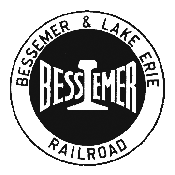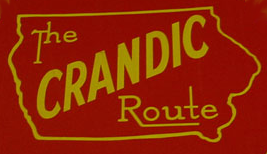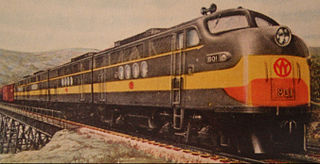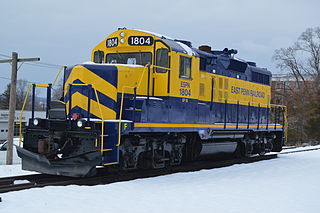
The Denver and Rio Grande Western Railroad, often shortened to Rio Grande, D&RG or D&RGW, formerly the Denver & Rio Grande Railroad, was an American Class I railroad company. The railroad started as a 3 ft narrow-gauge line running south from Denver, Colorado, in 1870. It served mainly as a transcontinental bridge line between Denver and Salt Lake City, Utah. The Rio Grande was also a major origin of coal and mineral traffic.

Ennis is a city in eastern Ellis County, Texas, United States. The population is 20,159 according to the 2020 census, with an estimated population of 21,210 in 2021. Ennis is home to the annual National Polka Festival.

BNSF Railway is the largest freight railroad in the United States. One of six North American Class I railroads, BNSF has 35,000 employees, 32,500 miles (52,300 km) of track in 28 states, and nearly 8,000 locomotives. It has three transcontinental routes that provide rail connections between the western and eastern United States. BNSF trains traveled over 169 million miles in 2010, more than any other North American railroad.

The Monon Railroad, also known as the Chicago, Indianapolis, and Louisville Railway from 1897 to 1971, was an American railroad that operated almost entirely within the state of Indiana. The Monon was merged into the Louisville and Nashville Railroad in 1971, and much of the former Monon right of way is owned today by CSX Transportation. In 1970, it operated 540 miles (870 km) of road on 792 miles (1,275 km) of track; that year it reported 1320 million ton-miles of revenue freight and zero passenger-miles.

The Bessemer and Lake Erie Railroad is a class II railroad that operates in northwestern Pennsylvania and northeastern Ohio.

The Grand Trunk Western Railroad Company was an American subsidiary of the Grand Trunk Railway, later of the Canadian National Railway operating in Michigan, Illinois, Indiana, and Ohio. Since a corporate restructuring in 1971, the railroad has been under CN's subsidiary holding company, the Grand Trunk Corporation. Grand Trunk Western's routes are part of CN's Michigan Division. Its primary mainline between Chicago and Port Huron, Michigan serves as a connection between railroad interchanges in Chicago and rail lines in eastern Canada and the Northeastern United States. The railroad's extensive trackage in Detroit and across southern Michigan has made it an essential link for the automotive industry as a hauler of parts and automobiles from manufacturing plants.

The Cedar Rapids and Iowa City Railway, also known as the CRANDIC, is a Class III railroad operating in the US state of Iowa.

There have been two uses of Columbus and Greenville Railway, both for the same rail line.

The Livonia, Avon and Lakeville Railroad is a short line railroad that operates in Livingston County and Monroe County in New York, United States. The railroad interchanges with CSX at Genesee Junction in Chili, New York, the Rochester and Southern Railroad (RSR) at Genesee Junction and the RSR's Brooks Avenue Yard in Gates, New York, and with the Rochester & Genesee Valley Railroad Museum at Industry, New York. Their primary freight consists of food products - grains and corn syrup. In 1997, the Livonia, Avon and Lakeville Railroad was selected as Short Line Railroad of the Year by industry trade journal Railway Age. The LAL is also the parent company for the Bath and Hammondsport Railroad, the Western New York and Pennsylvania Railroad and the Ontario Midland Railroad.

The St. Louis Southwestern Railway Company, known by its nickname of "The Cotton Belt Route" or simply "Cotton Belt", is a former Class I railroad that operated between St. Louis, Missouri, and various points in the U.S. states of Arkansas, Tennessee, Louisiana, and Texas from 1891 to 1980, when the system added the Rock Island's Golden State Route and operations in Kansas, Oklahoma, and New Mexico. The Cotton Belt operated as a Southern Pacific subsidiary from 1932 until 1992, when its operation was assumed by Southern Pacific Transportation Company.

The Blacklands Railroad is a class III short-line railroad headquartered in Sulphur Springs, Texas.

The New York, Ontario and Western Railway, commonly known as the O&W or NYO&W, was a regional railroad founded in 1868. The last train ran from Norwich, New York to Middletown, New York in 1957, after which it was ordered liquidated by a U.S. bankruptcy judge. It was the first notable U.S. railroad with its mainline entirely abandoned.
The East Tennessee & Western North Carolina Railroad, affectionately called the "Tweetsie" as a verbal acronym of its initials (ET&WNC) but also in reference to the sound of its steam whistles, was a primarily 3 ft narrow gauge railroad established in 1866 for the purpose of serving the mines at Cranberry, North Carolina.

The Black Hills Central Railroad is a heritage railroad that operates in Keystone, South Dakota, United States. The railroad was added to the National Register of Historic Places on February 5, 2003.

The Detroit and Mackinac Railway, informally known as the "Turtle Line", was a railroad in the northeastern part of the Lower Peninsula of the U.S. state of Michigan. The railroad had its main offices and shops in Tawas City with its main line running from Bay City north to Cheboygan, and operated from 1894 to 1992.
The Oklahoma Central Railroad, (OCR) earlier the Oklahoma Central Railway, was a railroad operating in the U.S. state of Oklahoma from 1907 to 1917. It was formed by Dorset Carter of Purcell, Indian Territory, and other business interests. The corporation started life on September 20, 1904 as the Canadian Valley and Western Railway Company. It changed its name to the Oklahoma Central Railway Company on September 27, 1905. Construction was started in Lehigh, Oklahoma, in 1906 and was completed to Chickasha, Oklahoma, in 1908. The route was primarily constructed to transport coal from the mines at Lehigh to Purcell in order to service steam locomotives on the Santa Fe, which maintained a division point at that location.

The Escanaba & Lake Superior Railroad is a Class III shortline railroad that operates 347 miles (558 km) of track in Northeastern Wisconsin and the Upper Peninsula of Michigan. Its main line runs 208 miles (335 km) from Rockland, Michigan, to Green Bay, Wisconsin, and it also owns various branch lines and out-of-service track. In 1897, the Escanaba River Company built a seven-mile (11 km) railroad from Wells, Michigan, to tap a large hardwood timber stand at LaFave’s Hill. In 1898, the company name was changed to the Escanaba & Lake Superior Railway (E&LS).

East Penn Railroad is a short-line railroad that operates a number of mostly-unconnected lines in Pennsylvania and Delaware. Except for two industrial park switching operations, all are former Pennsylvania Railroad or Reading Company lines, abandoned or sold by Conrail or its predecessors.
The Stephenville North & South Texas Railway (SN&ST) was incorporated in Texas on February 4, 1907 by Stephenville and Hamilton business interests. Its original standard gauge 43 mile line was built between Stephenville and Hamilton and completed in late 1907. The first train operated between Stephenville and Hamilton on Christmas Day 1907. Regular service began in January 1908. Four apparently identical wooden depots of a standard design were built at Hamilton, Carlton, Spurlin, and Alexander. The SN&ST shared a union station with its original primary railroad connection, the long established Fort Worth & Rio Grande Railroad at Stephenville.
Lake Superior and Ishpeming Railroad No. 23 is a preserved SC-4 class 2-8-0 "consolidation" type steam locomotive originally built by the ALCO in January 1910 for the Lake Superior and Ishpeming Railroad as No. 9. It was renumbered 23 in 1923. It was used for pulling carloads of iron ore, as well as some passenger trains on branch lines, until 1962. In 1963, it was leased to the Marquette and Huron Mountain tourist railroad for use in excursion service between Marquette and Big Bay, until 1974. It was the locomotive that had the longest operating career on the M&HM. After the M&HM was shut down in 1984, No. 23 was sold off to the Empire State Railway Museum in Phoenicia, New York, where it remained as a display piece until 2002. That same year, ESRM announced that they would restore the locomotive to operating condition, and they began the rebuilding process at the Catskill Mountain Railroad's Kingston yard site. As of 2023, No. 23 is still undergoing restoration.















